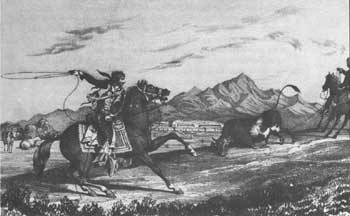






Historical Background
The Spanish Conquistadors and Padres (continued)
OUR SPANISH HERITAGE
Although the one-time Spanish territory gained by the United States in the trans-Mississippi West from Mexico was enormous and the gold soon discovered in California vitally affected Western development, perhaps the most rewarding and durable value of the Spanish borderlands was the heritage that lay in the land—from the Pacific to the Atlantic roughly south of the 40th parallel.
This heritage is most clearly evidenced by Spanish place names—from Castillo de San Marcos, in Florida, to San Juan Capistrano Mission, on the Pacific coast. Florida, Colorado, Nevada, and California are Spanish names, and New Mexico is only slightly anglicized. The nomenclature of scores of cities, counties, rivers, and mountains also reveals that the Spaniards were the first Europeans to trod the land.
The language of Castile lingers not only in place names in the old Spanish borderlands, but more vividly on the tongues of men. Hundreds of words of Spanish derivation also enrich the modern English vocabulary; a few examples are lasso, calaboose, rodeo, sombrero, mesquite, and arroyo. From Florida to California, the Roman Catholic Church has thousands of adherents, and other aspects of Spanish culture are present. Architecture has the flavor of Madrid and Granada; ornamentation, of Oaxaca and Saltillo; art, of Mexico City and Guadalajara.
 |
| California vaqueros ply their trade. San José Mission is in the background. From a lithograph by L. M. Lefevre, published in 1839, after a drawing by Captain Smyth. (Courtesy, Bancroft Library, University of California.) |
The origins of the cattle industry that has become the backbone of the Western economy are Spanish. The practice of working cattle from horseback, branding, trail driving, roundups, and even the cattle themselves and other livestock are all of Spanish origin. Less obvious, but equally important, elements of the Spanish heritage are various modifications of statutory and common law that are attributable directly to the regulamientos of Spain. Among these are property, mining, and range laws. Also, the arid Western States have adopted the Spanish concept of prior usage rights to water in streams and rivers instead of the age-old English doctrine of riparian rights.
In all these ways, and in numerous others, Spanish conquistadors, padres, and settlers have left their mark on the American image.
 |
 |
http://www.cr.nps.gov/history/online_books/explorers-settlers/intro9.htm
Last Updated: 22-Mar-2005